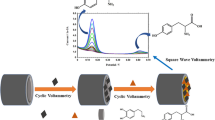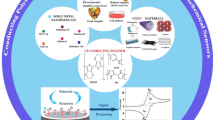Abstract
Nitrophenol sensors have garnered interest in pharmaceuticals, agriculture, environment safety and explosives. Various methods have been proposed to detect 4-nitrophenol, but nitrophenol isomers such as 2,4-dinitrophenol (DNP) and 2,4,6-trinitrophenol have been comparatively less studied. For the first time, the present work explores graphitic nanocarbon, i.e., carbon black (CB) interface for sensing of DNP. Two reduction potentials were noted at − 0.48 and − 0.64 V for o-NO2 and p-NO2 moieties, respectively, at CB/GCE. At the same time, bare GCE (glassy carbon electrode) shows a single reduction potential at − 0.7 V. The electrocatalytic effect and adsorption ability of the interface was studied from the DNP concentration effect. Scan rate and pH studies suggest that the CB acquires four electrons for NO2 reduction by the diffusion phenomenon. A broad detection range of 10–250 µM DNP with a very low detection limit of 0.13 (o-form) and 0.15 µM (p-form) was achieved using the CB interface. The real-time applicability of the fabricated sensor was evaluated using commercially available beverages with excellent recovery values. The stability, repeatability and reproducibility of the CB interface were successfully confirmed. Comparison of the sensing parameters of the developed sensor with those reported in literature reveals excellent detection limit and response time for the CB-interfaced DNP sensor, indicating its potential for environmental and commercial applications.








Similar content being viewed by others
References
Gemini VL, Gallego A, Tripodi V, Corach D, Planes EI, Korol SE (2007) Microbial degradation and detoxification of 2,4-dinitrophenol in aerobic and anoxic processes. Int Biodeterior Biodegr 60(4):226–230. https://doi.org/10.1016/j.ibiod.2007.03.006
Grundlingh J, Dargan PI, El-Zanfaly M, Wood DM (2011) 2,4-dinitrophenol (DNP): a weight loss agent with significant acute toxicity and risk of death. J Med Toxicol 7(3):205. https://doi.org/10.1007/s13181-011-0162-6
Dhanasekaran T, Manigandan R, Padmanaban A, Suresh R, Giribabu K, Narayanan V (2019) Fabrication of Ag@Co-Al layered double hydroxides reinforced poly(o-phenylenediamine) nanohybrid for efficient electrochemical detection of 4-nitrophenol, 2,4-dinitrophenol and uric acid at nano molar level. Sci Rep 9(1):13250. https://doi.org/10.1038/s41598-019-49595-y
Chen L, Cheng Z, Peng X, Qiu G, Wang L (2022) Eu-doped MOF-based high-efficiency fluorescent sensor for detecting 2,4-dinitrophenol and 2,4,6-trinitrophenol simultaneously. Anal Methods 14(1):44–51. https://doi.org/10.1039/D1AY01747K
Hasani M, Shariati-Rad M, Bidad E (2014) Simultaneous determination of mixtures of nitrophenols using multivariate curve resolution-alternating least squares. J Iran Chem Soc 11(4):1137–1145. https://doi.org/10.1007/s13738-013-0382-6
Wang J, Jin W, Zhang X, Hu C, Luo Q, Lin Y, Hu S (2014) Rapid in situ detection of ultratrace 2,4-dinitrotoluene solids by a sandwiched paper-like electrochemical sensor. Anal Chem 86(16):8383–8390. https://doi.org/10.1021/ac501973x
Wu S, Fan S, Tan S, Wang J, Li C-P (2018) A new strategy for the sensitive electrochemical determination of nitrophenol isomers using β-cyclodextrin derivative-functionalized silicon carbide. RSC Adv 8(2):775–784. https://doi.org/10.1039/C7RA12715D
Makuch B, Gazda K, Kamiśnski M (1993) Determination of phenol and monochlorophenols in water by reversed-phase liquid chromatography. Anal Chim Acta 284(1):53–58. https://doi.org/10.1016/0003-2670(93)80007-8
Heberer T, Stan H-J (1997) Detection of more than 50 substituted phenols as their t-butyldimethylsilyl derivatives using gas chromatography-mass spectrometry. Anal Chim Acta 341(1):21–34. https://doi.org/10.1016/S0003-2670(96)00557-0
Robert TA, Hagardorn AN (1983) Analysis and kinetics of 2,4-dinitrophenol in tissues by capillary gas chromatography–mass spectrometry. J Chromatogr 276(1):77–84
Moser AC, Trenhaile S, Frankenberg K (2018) Studies of antibody-antigen interactions by capillary electrophoresis: a review. Methods 146:66–75. https://doi.org/10.1016/j.ymeth.2018.03.006
Fang M, Lei F, Zhou J, Wu Y-N, Gong Z-Y (2014) Rapid, simple and selective determination of 2,4-dinitrophenol by molecularly imprinted spin column extraction coupled with fluorescence detection. Chin Chem Lett 25(11):1492–1494. https://doi.org/10.1016/j.cclet.2014.06.015
Sun Z, Li Y, Ma Y, Li L (2017) Dual-functional recyclable luminescent sensors based on 2D lanthanide-based metal-organic frameworks for highly sensitive detection of Fe3+ and 2,4-dinitrophenol. Dyes Pigm 146:263–271. https://doi.org/10.1016/j.dyepig.2017.07.015
Üzer A, Erçağ E, Apak R (2004) Selective spectrophotometric determination of trinitrotoluene, trinitrophenol, dinitrophenol and mononitrophenol. Anal Chim Acta 505(1):83–93. https://doi.org/10.1016/S0003-2670(03)00674-3
Yin H, Zhou Y, Han R, Qiu Y, Ai S, Zhu L (2012) Electrochemical oxidation behavior of 2,4-dinitrophenol at hydroxylapatite film-modified glassy carbon electrode and its determination in water samples. J Solid State Electrochem 16(1):75–82. https://doi.org/10.1007/s10008-010-1280-9
Bebeselea A, Manea F, Burtica G, Picken S, Schoonman JJC (2009) Electrochemical determination of 2, 4-dinitrophenol from aqueons solution at expanded graphite-carbon nanofiber–epoxy composite electrode. Carbon 13:14
Jing T, Xia H, Niu J, Zhou Y, Dai Q, Hao Q, Zhou Y (2011) Determination of trace 2, 4-dinitrophenol in surface water samples based on hydrophilic molecularly imprinted polymers/nickel fiber electrode. Biosens Bioelectron 26(11):4450–4456
Yang P, Cai H, Liu S, Wan Q, Wang X, Yang NJE (2011) Electrochemical reduction of 2, 4-dinitrophenol on nanocomposite electrodes modified with mesoporous silica and poly (vitamin B1) films. Electrochim Acta 56(20):7097–7103
Liu Y, Zhu L, Zhang Y, Tang HJS, Chemical AB (2012) Electrochemical sensoring of 2, 4-dinitrophenol by using composites of graphene oxide with surface molecular imprinted polymer. Sens Actuat 171:1151–1158
Wang Y, Cao W, Wang L, Zhuang Q, Ni YJMA (2018) Electrochemical determination of 2, 4, 6-trinitrophenol using a hybrid film composed of a copper-based metal organic framework and electroreduced graphene oxide. Microchim Acta 185(6):1–9
Ahmad K, Mohammad A, Mathur P, Mobin SMJEA (2016) Preparation of SrTiO3 perovskite decorated rGO and electrochemical detection of nitroaromatics. Electrochim Acta 215:435–446
Kim Y-J, Hong I, Shim J, An J-CJCL (2020) Preparation and characterization of black liquor-derived activated carbon by self-chemical activation. Carbon Lett 30(2):115–121
Kim KH, Kim M-J, Kim JW, Lee KM, Kim HG, Lee Y-SJCL (2019) Enhanced creep behavior of carbon black/epoxy composites with high dispersion stability by fluorination. Carbon Lett 29(6):643–648
Zhang D, Zhang C, Wang Q, Li S, Zhao X, Luo HJCL (2020) Preparation and electrochemical properties of self-doped nitrogen porous carbon derived from Zn-MOFs. Carbon Lett 30(3):315–324
Arduini F, Amine A, Majorani C, Di Giorgio F, De Felicis D, Cataldo F, Moscone D, Palleschi GJE (2010) High performance electrochemical sensor based on modified screen-printed electrodes with cost-effective dispersion of nanostructured carbon black. Electrochim Commun 12(3):346–350
Carvalho RC, Mandil A, Prathish KP, Amine A, Brett CMJE (2013) Carbon nanotube, carbon black and copper nanoparticle modified screen printed electrodes for amino acid determination. Electroanalysis 25(4):903–913
Vicentini FC, Ravanini AE, Figueiredo-Filho LC, Iniesta J, Banks CE, Fatibello-Filho OJEA (2015) Imparting improvements in electrochemical sensors: evaluation of different carbon blacks that give rise to significant improvement in the performance of electroanalytical sensing platforms. Electrochim Acta 157:125–133
Razumiene J, Barkauskas J, Kubilius V, Meškys R, Laurinavičius VJT (2005) Modified graphitized carbon black as transducing material for reagentless H2O2 and enzyme sensors. Talanta 67(4):783–790
Arduini F, Di Nardo F, Amine A, Micheli L, Palleschi G, Moscone DJE (2012) Carbon black-modified screen-printed electrodes as electroanalytical tools. Electroanalysis 24(4):743–751
Dinesh B, Devi KS, Kumar AS (2017) Curcumin-quinone immobilised carbon black modified electrode prepared by in-situ electrochemical oxidation of curcumin-phytonutrient for mediated oxidation and flow injection analysis of sulfide. J Electronanal Chem 804:116–127
Shalini Devi K, Anusha N, Raja S, Senthil Kumar A (2018) A new strategy for direct electrochemical sensing of a organophosphorus pesticide, triazophos, using a coomassie brilliant-blue dye surface-confined carbon-black-nanoparticle-modified electrode. ACS Appl Nano Mater 1(8):4110–4119
Dinesh B, Saraswathi R, Kumar AS (2017) Water based homogenous carbon ink modified electrode as an efficient sensor system for simultaneous detection of ascorbic acid, dopamine and uric acid. Electrochim Acta 233:92–104
Cui G, Yoo JH, Lee JS, Yoo J, Uhm JH, Cha GS, Nam H (2001) Effect of pre-treatment on the surface and electrochemical properties of screen-printed carbon paste electrodes. Analyst 126(8):1399–1403
Osbome M, Seddon B, Dryfe R, Lagger G, Loyall U, Schäfer H, Girault HJJ (1996) Excimer laser-induced electrochemical activity in carbon ink films. J Electroanal Chem 417(1–2):5–15
Bleasdale EE, Thrower SN, Petróczi A (2018) Would you use it with a seal of approval? Important attributes of 2, 4-dinitrophenol (2, 4-DnP) as a hypothetical pharmaceutical product. Front Psychiatry 9:124
Wang X-G, Wu Q-S, Liu W-Z, Ding Y-P (2006) Simultaneous determination of dinitrophenol isomers with electrochemical method enhanced by surfactant and their mechanisms research. Electrochim Acta 52(2):589–594
Irandoust M, Haghighi M, Taherpour AA, Zolfaghar NJ (2019) Electrochemical sensing of 2-methyl-4, 6-dinitrophenol by nanomagnetic core shell linked to carbon nanotube modified glassy carbon electrode. Mater Sci 99:211–221
Sakthivel M, Ramaraj S, Chen S-M, Dinesh BJ (2018) Synthesis of rose like structured LaCoO3 assisted functionalized carbon nanofiber nanocomposite for efficient electrochemical detection of anti-inflammatory drug 4-aminoantipyrine. Electrochim Acta 260:571–581
Sakthivel M, Ramaraj S, Chen S-M, Dinesh B (2018) A highly conducting flower like Au nanoparticles interconnected functionalized CNFs and its enhanced electrocatalytic activity towards hydrazine through direct electron transfer. J Taiwan Inst Chem Eng 82:64–74
Subhan MA, Saha PC, Rahman MM, Ahmed J, Asiri AM, Al-Mamun MJ (2018) Fabrication of a 2, 4-dinitrophenol sensor based on Fe 3 O 4@ Ag@ Ni nanomaterials and studies on their antibacterial properties. N J Chem 42(2):872–881
Scanlon JJH (1984) Determination of nitrophenols by high performance liquid chromatography with electrochemical detection. Georgia Institute of Technology, Georgia
Mohammad A, Ahmad K, Rajak R, Mobin SM (2018) Binder free modification of glassy carbon electrode by employing reduced graphene oxide/ZnO composite for voltammetric determination of certain nitroaromatics. Electroanalysis 30(2):274–282
Acknowledgements
The authors gratefully acknowledge the infrastructural support from SASTRA Deemed University. Furthermore, UM Krishnan and KSS Devi sincerely thank the RCUK grant (MR/P027881/1) and DST SERB (PDF0001764) Scheme, respectively, for financial aid.
Author information
Authors and Affiliations
Corresponding author
Ethics declarations
Conflict of interest
The authors declare that they have no known competing financial interests or personal relationships that could have influenced the work reported in this paper.
Additional information
Publisher's Note
Springer Nature remains neutral with regard to jurisdictional claims in published maps and institutional affiliations.
Rights and permissions
About this article
Cite this article
Dinesh, B., Aadhav, A., Devi, K.S.S. et al. Electrocatalytic reduction of 2,4 dinitrophenol on carbon black-modified glassy carbon electrode and its selective recognition in cold beverages. Carbon Lett. 32, 1017–1029 (2022). https://doi.org/10.1007/s42823-022-00334-w
Received:
Revised:
Accepted:
Published:
Issue Date:
DOI: https://doi.org/10.1007/s42823-022-00334-w




